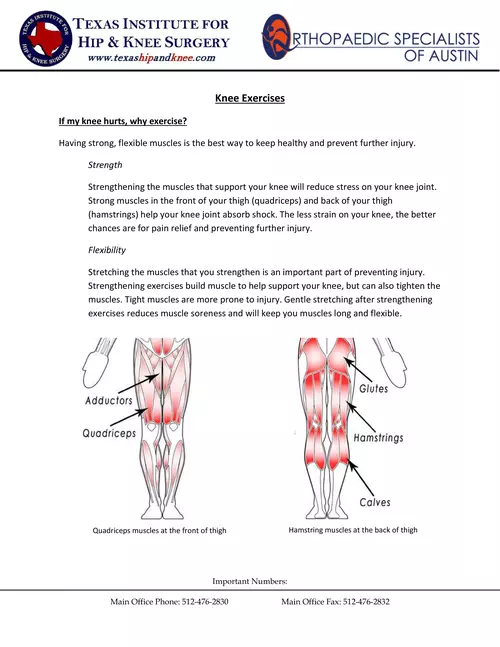
Knee Exercises
Knee strengthening exercises. Try to complete the exercises at least three times a day. Keep your leg elevated to decrease swelling.
adsPart of the document
Knee Exercises If my knee hurts, why exercise?
Having strong, flexible muscles is the best way to keep healthy and prevent further injury.
Strength
Strengthening the muscles that support your knee will reduce stress on your knee joint.
Strong muscles in the front of your thigh (quadriceps) and back of your thigh
(hamstrings) help your knee joint absorb shock. The less strain on your knee, the better
chances are for pain relief and preventing further injury.
Flexibility
Stretching the muscles that you strengthen is an important part of preventing injury.
Strengthening exercises build muscle to help support your knee, but can also tighten the
muscles. Tight muscles are more prone to injury. Gentle stretching after strengthening
exercises reduces muscle soreness and will keep you muscles long and flexible.
Quadriceps muscles at the front of thigh
Hamstring muscles at the back of thigh
Important Numbers:
Main Office P
hone: 512-476-2830 Main Office Fax: 512-476-2832
How do I start exercising?
You doctor or physical therapist will tell you which exercises are right for you.
Start slowly.
Building muscle strength takes time. As you get stronger, gradually
increase the number of exercise prepetition or add
weight to an exercise.
Do not ignore pain. You should not feel serious pain after exercise. It is typical to feel
stiff or a bit sore the day after you exercise. If you feel so sore that it is difficult to move,
then you have overdone your exercise. Rest is the best thing for you sore muscles.
Ask questions. Talk to your doctor or therapist if you have any pain or are unsure of
how many exercises to do, or how often to do them.
Strengthening Exercises
Warm up with 5-10 minutes of low impact activity, like walking or cycling, before doing
these exercises.
Straight-Leg Lift
Lie on your back with one leg bent and the other straight. Tighten the thigh
muscles in
your straight leg and slowly lift it until it is about a foot off the floor. Hold it or 3 to 5
seconds. Slowly lower your leg to the floor. Repeat and switch side.
Do: Keep your upper body relaxed and tighten your stomach muscles to keep your back
flat against the floor.
Do not:
Arch your back. Do not lift your leg too high with a jerking motion.
You should feel this exercise mostly in the front of your thigh.
Important Numbers:
Main Office P
hone: 512-476-2830 Main Office Fax: 512-476-2832
Single-Leg Dip
Place two chairs on either side of you to help with balance. Lift one leg slightly in front
of you. Plant your weight on the other leg. Slowly lower yourself down a few inches,
pushing your weight onto the heel of your supporting leg. Hold for 3 to 5 seconds.
Slowly straighten up. Repeat and switch sides.
Do: Sit back as if there was chair behind you.
Do not:
Let the knee of your supporting leg move forward over your toes.
Hamstring Curls
Hold on to the back of a chair for balance. Plant your weight onto your supporting leg. Lift the
other foot and bring the heel up toward your buttocks. Hold for 3 to 5 seconds. Slowly lower
your leg. Repeat and switch sides.
Do: Keep your knees close together.
Do not:
Lock the knee of your supporting leg. Do not bring your heel up past a 90 degree angle.
You should feel this exercise in the front and back of your thigh, hip, and buttocks.
You should feel this exercise at the back of your thigh.
Important Numbers:
Main Office P
hone: 512-476-2830 Main Office Fax: 512-476-2832
Knee Stabilization Series
Hold onto the back of chair for balance. Slightly loft one leg. Plant your weight on your
supporting leg. Tighten you thigh muscles in your lifted leg and slowly move it in the direction
shown. Hold for 3 to 5 seconds. Slowly return to the start and repeat
. Turn your body 90
degrees to begin the next exercise in the series.
Do: Focus on your supporting leg. It is working just as hard as the moving leg.
Do not:
Lock the knee of your supporting leg. Do not arch your back or lean to either side
during these
exercises.
Wall Squat


